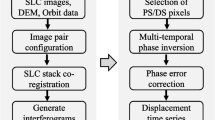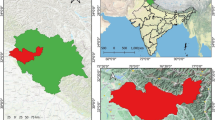Abstract
Peshawar is one of the most densely populated cities of Pakistan with high urbanization rate. The city overexploits groundwater resources for household and commercial usage which has caused land subsidence. Land subsidence has long been an issue in Peshawar due to insufficient groundwater removal. In this research, we employ the persistent scatterer interferometry synthetic aperture radar (PS-InSAR) technique with Sentinel-1 imaging data to observe the yearly land subsidence and generate accumulative time-series maps for the years (2018 to 2020) using the SAR PROcessing tool (SARPROZ). The PS-InSAR findings from two contiguous paths are combined by considering the variance over the overlap** area. The subsidence rates in the Peshawar are from −59 to 17 mm/yr. The results show that subsidence is −28.48 mm/yr in 2018, the subsidence reached −49.02 mm/yr in 2019, while in 2020, the subsidence reached −49.90 mm/yr. The findings indicate a notable rise in land subsidence between the years 2018 and 2020. Subsidence is predicted in the research region primarily due to excessive groundwater removal and soil consolidation induced by surficial loads. The correlation of land subsidence observations with groundwater levels and precipitation data revealed some relationships. Overall, the proposed method efficiently monitors, maps, and detects subsidence-prone areas. The utilization of land subsidence maps will enhance the efficiency of urban planning, construction of surface infrastructure, and the management of risks associated with subsidence.
















Similar content being viewed by others
References
Amin G, Shahzad MI, Jaweria S, Zia I (2021) Measuring land deformation in a mega city Karachi-Pakistan with sentinel SAR interferometry. Geocarto International, pp 1–20
Beladam O, Balz T, Mohamadi B, Abdalhak M (2019) Using ps-insar with sentinel-1 images for deformation monitoring in northeast Algeria. Geosciences 9:315
Bui LK, Featherstone W, Filmer M (2020) Disruptive influences of residual noise, network configuration and data gaps on InSAR-derived land motion rates using the SBAS technique. Remote Sens Environ 247:111941
Chaussard E, Wdowinski S, Cabral-Cano E, Amelung F (2014) Land subsidence in central Mexico detected by ALOS InSAR time-series. Remote Sens Environ 140:94–106
Chen F, Lin H, Zhou W, Hong T, Wang G (2013) Surface deformation detected by ALOS PALSAR small baseline SAR interferometry over permafrost environment of Beiluhe section, Tibet Plateau, China. Remote Sens Environ 138:10–18
Cianflone G, Vespasiano G, Tolomei C, De Rosa R, Dominici R, Apollaro C, Walraevens K, Polemio M (2022) Different ground subsidence contributions revealed by integrated discussion of Sentinel-1 datasets, well discharge, stratigraphical and geomorphological data: the case of the Gioia Tauro Coastal Plain (Southern Italy). Sustainability 14:2926
Crosetto M, Devanthéry N, Cuevas-González M, Monserrat O, Crippa B (2015) Exploitation of the full potential of PSI data for subsidence monitoring. Proc Int Assoc Hydrol Sci 372:311–314
Du Z, Ge L, Ng AH-M, ** land subsidence over the eastern Bei**g city using satellite radar interferometry. Int J Digital Earth 11:504–519
Ferretti A, Fumagalli A, Novali F, Prati C, Rocca F, Rucci A (2011) A new algorithm for processing interferometric data-stacks: SqueeSAR. IEEE Trans Geosci Remote Sens 49:3460–3470
Ferretti A, Prati C, Rocca F (2001) Permanent scatterers in SAR interferometry. IEEE Trans Geosci Remote Sens 39:8–20
Gahalaut VK (2009) Coulomb stress change due to 2005 Kashmir earthquake and implications for future seismic hazards. J Seismol 13:379–386
Galve JP, Castañeda C, Gutiérrez F, Herrera G (2015) Assessing sinkhole activity in the Ebro Valley mantled evaporite karst using advanced DInSAR. Geomorphology 229:30–44
Ge L, Ng AH-M, Li X, Abidin HZ, Gumilar I (2014) Land subsidence characteristics of Bandung Basin as revealed by ENVISAT ASAR and ALOS PALSAR interferometry. Remote Sens Environ 154:46–60
Goel K, Adam N (2012) An advanced algorithm for deformation estimation in non-urban areas. ISPRS J Photogramm Remote Sens 73:100–110
Hooper A (2008) A multi‐temporal InSAR method incorporating both persistent scatterer and small baseline approaches. Geophys Res Lett 35:16
Hussain MA, Chen Z, Shoaib M, Shah SU, Khan J, Ying Z (2022) Sentinel-1A for monitoring land subsidence of coastal city of Pakistan using Persistent Scatterers In-SAR technique. Sci Rep 12:1–18
Hussain MA, Chen Z, Wang R, Shoaib M (2021) PS-InSAR-based validated landslide susceptibility map** along Karakorum Highway. Pakistan Remote Sensing 13:4129
Karimzadeh S, Matsuoka M (2020) Remote Sensing X-Band SAR Data for land subsidence and pavement monitoring. Sensors 20:4751
Khan AS, Khan SD, Kakar DM (2013) Land subsidence and declining water resources in Quetta Valley, Pakistan. Environ Earth Sci 70:2719–2727
Klemm H, Quseimi I, Novali F, Ferretti A, Tamburini A (2010) Monitoring horizontal and vertical surface deformation over a hydrocarbon reservoir by PSInSAR. First Break 28:5
Kumar V, Venkataramana G, Høgda KA (2011) Glacier surface velocity estimation using SAR interferometry technique applying ascending and descending passes in Himalayas. Int J Appl Earth Obs Geoinf 13:545–551
Lanari R, Lundgren P, Sansosti E (1998) Dynamic deformation of Etna volcano observed by satellite radar interferometry. Geophys Res Lett 25:1541–1544
Lauknes T, Shanker AP, Dehls J, Zebker H, Henderson I, Larsen Y (2010) Detailed rockslide map** in northern Norway with small baseline and persistent scatterer interferometric SAR time series methods. Remote Sens Environ 114:2097–2109
Li D, Hou X, Song Y, Zhang Y, Wang C (2020) Ground subsidence analysis in Tian** (China) based on Sentinel-1A data using MT-InSAR methods. Appl Sci 10:5514
Lu P, Bai S, Tofani V, Casagli N (2019) Landslides detection through optimized hot spot analysis on persistent scatterers and distributed scatterers. ISPRS J Photogramm Remote Sens 156:147–159
Ng AH-M, Ge L, Yan Y, Li X, Chang H-C, Zhang K, Rizos C (2010) Map** accumulated mine subsidence using small stack of SAR differential interferograms in the Southern coalfield of New South Wales, Australia. Eng Geol 115:1–15
Nof RN, Baer G, Ziv A, Raz E, Atzori S, Salvi S (2013) Sinkhole precursors along the Dead Sea, Israel, revealed by SAR interferometry. Geology 41:1019–1022
Nonaka T, Asaka T, Iwashita K, Ogushi F (2020) Evaluation of the trend of deformation around the Kanto Region estimated using the time series of PALSAR-2 Data. Sensors 20:339
Orhan O, Oliver-Cabrera T, Wdowinski S, Yalvac S, Yakar M (2021) Land subsidence and its relations with sinkhole activity in Karapınar region, Turkey: a multi-sensor InSAR time series study. Sensors 21:774
Pepe A, Calò F (2017) A review of interferometric synthetic aperture RADAR (InSAR) multi-track approaches for the retrieval of Earth’s surface displacements. Appl Sci 7:1264
Raucoules D, Le Mouélic S, Carnec C, Maisons C, King C (2003) Urban subsidence in the city of Prato (Italy) monitored by satellite radar interferometry. Int J Remote Sens 24:891–897
Roccheggiani M, Piacentini D, Tirincanti E, Perissin D, Menichetti M (2019) Detection and monitoring of tunneling induced ground movements using Sentinel-1 SAR interferometry. Remote Sens (Basel) 11:639
Shahzad N, Ding X, Wu S, Liang H (2020) Ground deformation and its causes in Abbottabad city, Pakistan from sentinel-1a data and mt-insar. Remote Sens (Basel) 12:3442
Shanker P, Casu F, Zebker HA, Lanari R (2011) Comparison of persistent scatterers and small baseline time-series InSAR results: a case study of the San Francisco bay area. IEEE Geosci Remote Sens Lett 8:592–596
Stramondo S, Bozzano F, Marra F, Wegmuller U, Cinti F, Moro M, Saroli M (2008) Subsidence induced by urbanisation in the city of Rome detected by advanced InSAR technique and geotechnical investigations. Remote Sens Environ 112:3160–3172
Surjan A, Parvin GA, Shaw R (2016) Impact of urban expansion on farmlands: a silent disaster, Urban disasters and resilience in Asia. Elsevier, pp 91–112
Talib O-C, Shimon W, Sarah K, Tonian R (2022) Detection of sinkhole activity in West-Central Florida using InSAR time series observations. Remote Sens Environ 269:112793
Teatini P, Castelletto N, Ferronato M, Gambolati G, Janna C, Cairo E, Marzorati D, Colombo D, Ferretti A, Bagliani A (2011) Geomechanical response to seasonal gas storage in depleted reservoirs: A case study in the Po River basin, Italy. J Geophys Res Earth Surf 116:F2
Usai S (2003) A least squares database approach for SAR interferometric data. IEEE Trans Geosci Remote Sens 41:753–760
Vilardo G, Ventura G, Terranova C, Matano F, Nardò S (2009) Ground deformation due to tectonic, hydrothermal, gravity, hydrogeological, and anthropic processes in the Campania Region (Southern Italy) from Permanent Scatterers Synthetic Aperture Radar Interferometry. Remote Sens Environ 113:197–212
Wang L, Marzahn P, Bernier M, Ludwig R (2020) Sentinel-1 InSAR measurements of deformation over discontinuous permafrost terrain, Northern Quebec, Canada. Remote Sens Environ 248:111965
Xu Y-S, Shen S-L, Ren D-J, Wu H-N (2016) Analysis of factors in land subsidence in Shanghai: a view based on a strategic environmental assessment. Sustainability 8:573
Yar P, Huafu J (2019) Horizontal development of built-up area and its impacts on the agricultural land of Peshawar city district (1991–2014). J Indian Soc Remote Sens 47:1537–1545
Yar P, Huafu J, Khan MA, Rashid W, Khan S (2022) Modification of land use/land cover and its impact on groundwater in Peshawar City, Pakistan. J Indian Soc Remote Sens 1:1–16
Zhang B, Wang R, Deng Y, Ma P, Lin H, Wang J (2019a) Map** the Yellow River Delta land subsidence with multitemporal SAR interferometry by exploiting both persistent and distributed scatterers. ISPRS J Photogramm Remote Sens 148:157–173
Zhang K, Ng AH-M, Ge L, Dong Y, Rizos C (2010) Multi-path PALSAR interferometric observations of the 2008 magnitude 8.0 Wenchuan earthquake. Int J Remote Sens 31:3449–3463
Zhang L, Arabameri A, Santosh M, Pal SC (2023) Land subsidence susceptibility map**: comparative assessment of the efficacy of the five models. Environ Sci Pollut Res 2:1–20
Zhang T, Shen W-B, Wu W, Zhang B, Pan Y (2019b) Recent surface deformation in the Tian** area revealed by Sentinel-1A data. Remote Sens (Basel) 11:130
Zhao C, Lu Z, Zhang Q, de La Fuente J (2012) Large-area landslide detection and monitoring with ALOS/PALSAR imagery data over Northern California and Southern Oregon, USA. Remote Sens Environ 124:348–359
Zhao Q, Ma G, Wang Q, Yang T, Liu M, Gao W, Falabella F, Mastro P, Pepe A (2019) Generation of long-term InSAR ground displacement time-series through a novel multi-sensor data merging technique: the case study of the Shanghai coastal area. ISPRS J Photogramm Remote Sens 154:10–27
Zhou L, Guo J, Hu J, Li J, Xu Y, Pan Y, Shi M (2017) Wuhan surface subsidence analysis in 2015–2016 based on Sentinel-1A data by SBAS-InSAR. Remote Sens (Basel) 9:982
Acknowledgements
This research is supported by the Chinese Government Scholarship.
Data availability
The data presented in the study are available on request from the first and corresponding author.
Funding
The study was supported by the National Natural Science Foundation of China (No. 41871305); National key R & D program of China (No.2017YFC0602204); Fundamental Research Funds for the Central Universities, China University of Geosciences (Wuhan) (No. CUGQY1945); Opening Fund of Key Laboratory of Geological Survey and Evaluation of Ministry of Education; and Fundamental Research Funds for the Central Universities (No. GLAB2019ZR02).
Author information
Authors and Affiliations
Contributions
Muhammad Afaq Hussain: Conceptualization, Methodology, Writing—original draft, Visualization, Data curation. Junaid Khan: Validation, Formal analysis. Zhanlong Chen: Writing—review & editing, Supervision, Investigation.
Corresponding author
Ethics declarations
Competing interests
The authors declare no competing interests.
Additional information
Responsible Editor: Rongrong Wan
Publisher’s Note
Springer Nature remains neutral with regard to jurisdictional claims in published maps and institutional affiliations.
Supplementary information
ESM 1
(DOCX 1990 kb)
Rights and permissions
Springer Nature or its licensor (e.g. a society or other partner) holds exclusive rights to this article under a publishing agreement with the author(s) or other rightsholder(s); author self-archiving of the accepted manuscript version of this article is solely governed by the terms of such publishing agreement and applicable law.
About this article
Cite this article
Hussain, M.A., Chen, Z. & Khan, J. Monitoring land subsidence in the Peshawar District, Pakistan, with a multi-track PS-InSAR technique. Environ Sci Pollut Res 31, 12271–12287 (2024). https://doi.org/10.1007/s11356-024-31995-x
Received:
Accepted:
Published:
Issue Date:
DOI: https://doi.org/10.1007/s11356-024-31995-x




